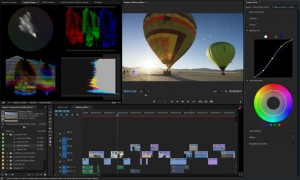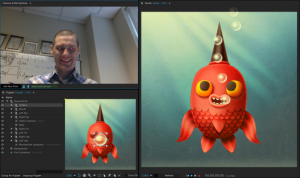In an effort to create some buzz around the new updates – to its already creative kitty – before NAB kicks-off, Adobe has revealed new color workflow options for Premiere Pro CC and debuted Adobe Character Animator, an easy-to-use animation program designed as a companion to After Effects CC.
In announcing the new Creative Cloud features, Adobe officials noted that Premiere Pro is increasingly becoming the centerpiece of a workflow that includes an expanding suite of mobile apps designed to move creative choices off the desktop and into the real world. “Everything has to flow into Premiere,” said Adobe director of video product management Bill Roberts, at a press briefing introducing the new capabilities.
Adobe didn’t announce a release date for the new features yet.
Premiere Pro CC
 The most prominent feature in this version of Premiere Pro is a new set of colour tools that draw on Adobe’s Lumetri Colour Engine. And a new Lumetri Colour panel (seen alongside) features familiar grading tools like curves, colour and saturation wheels, along with a new library of preloaded settings that give editors a head start on the look-creation process.
The most prominent feature in this version of Premiere Pro is a new set of colour tools that draw on Adobe’s Lumetri Colour Engine. And a new Lumetri Colour panel (seen alongside) features familiar grading tools like curves, colour and saturation wheels, along with a new library of preloaded settings that give editors a head start on the look-creation process.
Another promising addition is Morph Cuts, which is a new function designed to allow seamless edits to be made in interview footage. A combination of face-tracking, optical flow technology and intelligent frame insertion will let editors easily create completely smooth, imperceptible transitions in talking-head shots.
There is also Time Tuner, which automatically increases or decreases the duration of a clip or sequence by up to 10 per cent. Incorporated in both Premiere and Adobe Media Encoder, the software uses intelligent image analysis to figure out the best ways to imperceptibly manipulate running times by removing frames, etc.
After Effects CC
![]() A new library function in both After Effects and Premiere Pro (as seen alongside) allows all kinds of items to be dragged onto footage – looks, PSD files, vector graphics files, JPGs, and more. And the new Uninterrupted Preview feature means those text elements can be manipulated without stopping playback.
A new library function in both After Effects and Premiere Pro (as seen alongside) allows all kinds of items to be dragged onto footage – looks, PSD files, vector graphics files, JPGs, and more. And the new Uninterrupted Preview feature means those text elements can be manipulated without stopping playback.
A new After Effects Face Tracker can be used to automatically follow the position of a subject’s face in the frame. The user draws a rough mask around the face to be tracked, and can specify the level of tracking detail required. At a low level of data, faces can be accurately tracked and quickly blurred. A more extensive and precise collection of data, including mouth movements and the like, can be exported to Adobe’s Character Animator.
Character Animator
 Character Animator is being released in preview form this spring with the goal of gathering user feedback for a full-fledged release later. Characters can be imported as multilayer documents that, when structured and named properly, are automatically rigged as puppets. Facial animation can be generated by an animator’s performance to a face-tracking webcam, or by using the keyboard or mouse to control facial expressions and other body parts. Meanwhile, character behaviors like breathing can be defined and automated, and physics-based animation and effects like wind and dangling objects are part of the kit. It’s a work in progress, but already a promising application for artists who want to create a character in Photoshop or Illustrator and then animate that character without leaving the Creative Cloud ecosystem.
Character Animator is being released in preview form this spring with the goal of gathering user feedback for a full-fledged release later. Characters can be imported as multilayer documents that, when structured and named properly, are automatically rigged as puppets. Facial animation can be generated by an animator’s performance to a face-tracking webcam, or by using the keyboard or mouse to control facial expressions and other body parts. Meanwhile, character behaviors like breathing can be defined and automated, and physics-based animation and effects like wind and dangling objects are part of the kit. It’s a work in progress, but already a promising application for artists who want to create a character in Photoshop or Illustrator and then animate that character without leaving the Creative Cloud ecosystem.
Adobe Anywhere
Finally, the main action on the Adobe Anywhere front includes a new version that offers collaboration features without the Mercury Streaming Engine. That reduces the cost of hardware and simplifies the installation process, making Adobe Anywhere a more usable and affordable collaboration hub for customers who don’t require remote access.

